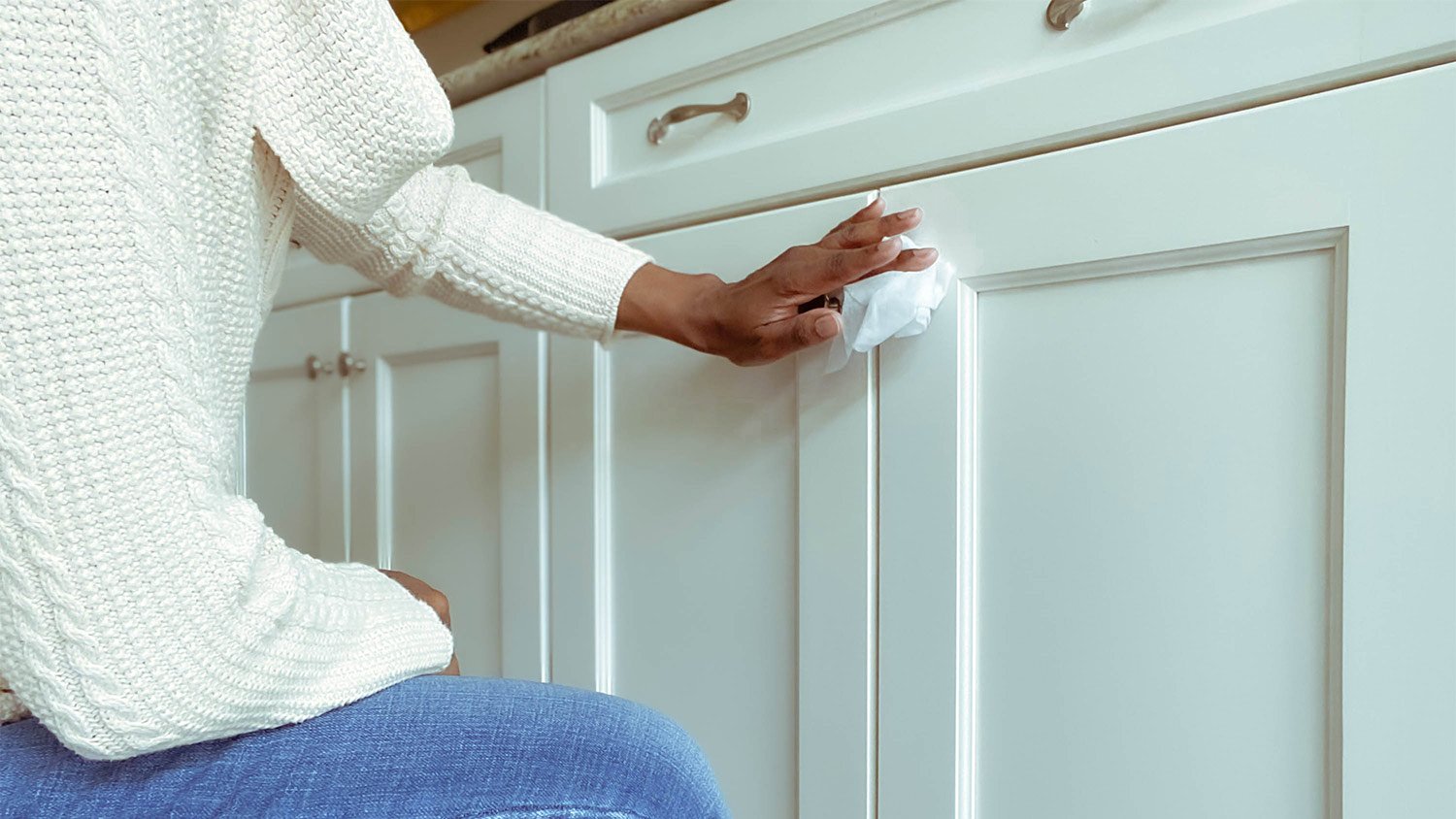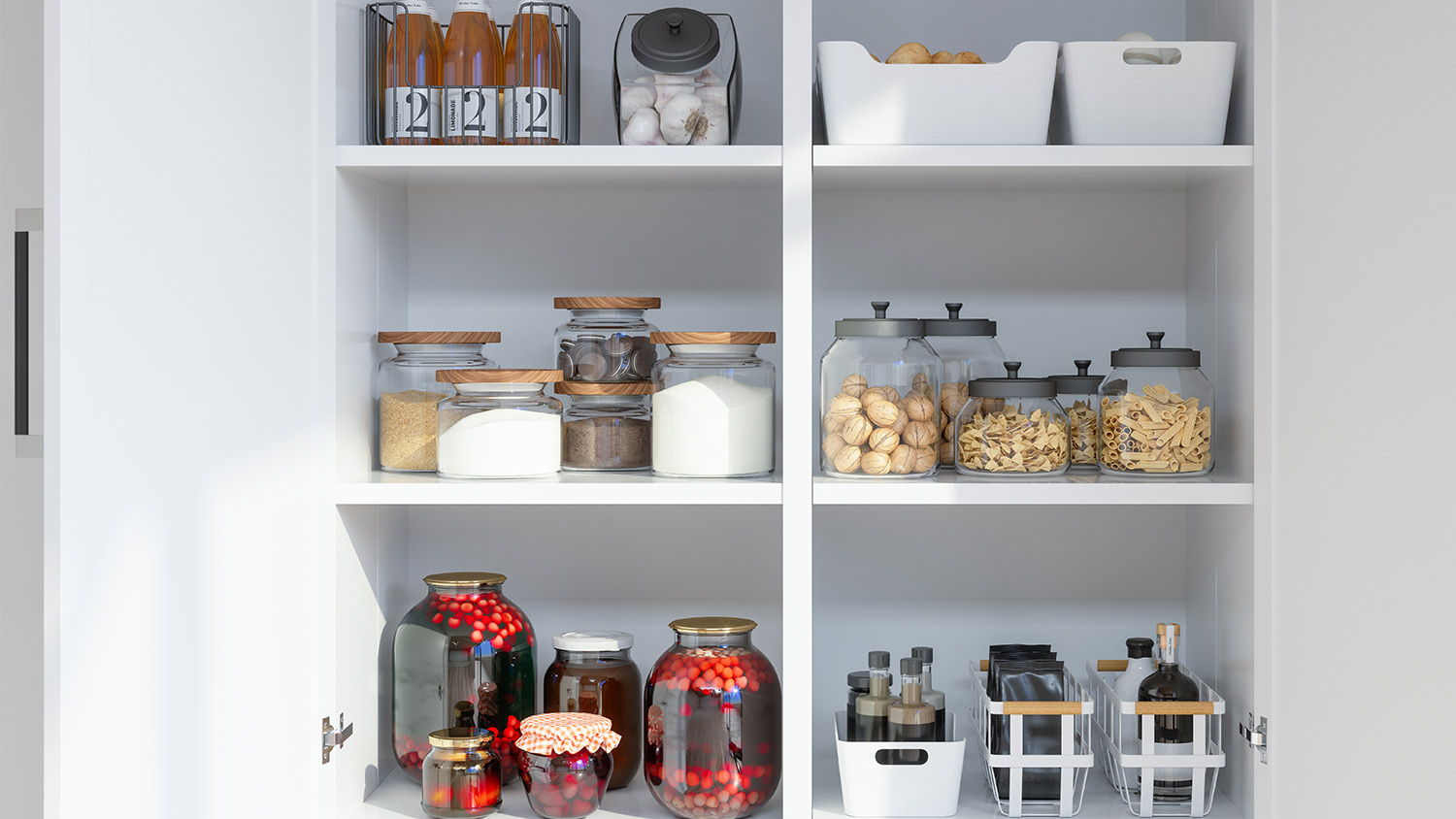How to Clean Kitchen Cabinets With Ease
Fill your cabinet with cooking tools, not grime


Keeping your kitchen clean requires constant vigilance. From pasta primavera on Sunday to tuna melts on Tuesday, the kitchen is a room of constant—often messy—activity. When it comes to cleaning your kitchen from top to bottom, a good place to start is your cabinets. Learn how to clean kitchen cabinets so well that they look showroom-ready.
Why Should I Clean My Kitchen Cabinets?
Whether it’s splashes of butter or drips of coffee, your cabinets will likely need a regular wipe-down. Not only will this keep them looking relatively neat between deep cleanings, but it'll also cut down on the amount of time and energy you'll need to expend.
"The material cabinet doors are made of, as well as the paint or stain on the cabinet doors, will be maintained and last longer by regularly wiping off dirt, food debris, and spills," says Asya Biddle, Expert Review Board member and manager of The Dust Busters janitorial company in Williamsport, PA.
How to Clean Kitchen Cabinets

When choosing store-bought or homemade cleaners for kitchen cabinets, it’s important to be sure that they’re safe to use on your cabinet material. Learn how to clean cabinets effectively, whether they are made of laminate or wood.
Purge the Contents
There are likely some expired bouillon cubes or even some cracked dishes hiding in the back of your cabinets. Now is a great time to purge the old stuff and start fresh.
Pull everything out of your cabinets so you can examine your pantry items and create better access to the cabinet for cleaning.
Check the expiration dates on all old food items and toss what’s no longer good.
Found multiples of some pantry items? See if you can combine them (if they are non-perishable) into labeled jars. If you have too much of one item, donate the unopened extras to a local food bank.
Make an honest assessment of your dishware. Do you need those four mugs you got from that road trip 10 summers ago? Donate what you don’t need to neighbors, friends, family, or via your local Buy Nothing group.
Wipe down any jars or dishware you plan to keep so they are sparkling clean when they return to the cabinet.
Set everything aside while you clean the cabinet interiors.
How to Clean Laminate or Painted Cabinets
Grab a gentle cleanser. Soap and water work well, but you can also mix up a homemade cleaning spray using 1 part vinegar and 1 part water (add a few drops of essential oil if you want to mask the strong vinegar scent).
Spray the cleanser in the cabinet, top to bottom and side to side. Be sure to clean the exterior as well.
Using a soft microfiber cloth or paper towels (don’t use anything more abrasive than that, or you risk damaging your cabinets), wipe down any dirt and grime.
Don’t forget the top: Most people forget to clean the top of the cabinets, allowing gunk to get caked on.
For extra-tough spots, make a paste with some baking soda and water and apply it to the cabinet. Use a little elbow grease to remove the dirt, then wipe away with a clean microfiber cloth.
Using your homemade cleaner and an old toothbrush, scrub the handles and drawer pulls until they sparkle. Wipe them clean with a fresh cloth.
Let the cabinets air-dry before putting everything back.
How to Clean Wood Cabinets
Use a special wood cleaning oil and a damp microfiber cloth to wipe down any grit on the inside and outside of your cabinets. Ensure your cloth is damp, not wet, as excess moisture can damage the wood.
Make a paste with vinegar and salt for any caked-on dirt. Using an old soft-bristled toothbrush, scrub the tough spot with a toothbrush to loosen the grime. Wipe clean with a fresh microfiber cloth.
Protect your wood cabinets by applying a small amount of wood conditioning oil to them using another clean cloth.
How to Clean Glass Cabinets
Wipe down any non-glass material with water and mild soap or another appropriate cleaner for the material. Avoid using oils on anything that touches glass, as it can leave hard-to-remove residue.
Use a commercial glass cleaner or a homemade spray of equal parts vinegar and water and spray the outside glass surface.
Wipe with a clean microfiber cloth to avoid streaking.
Clean the glass on the inside of the cabinet door using your spray and microfiber cloth.
How to Clean Stainless Steel Kitchen Cabinets
Dampen a microfiber cloth with water and a mild soap like dish soap, then wipe down to clean the stainless steel cabinets.
Using a clean microfiber cloth and warm water, wipe down cabinets again to remove any soap residue.
Wipe dry with a clean, dry microfiber cloth to avoid streaks or spots.
Tips for Keeping Your Kitchen Cabinets Clean

Beyond regularly cleaning kitchen cabinets, there are ways to protect them and keep them looking new for years to come. Avoid cabinet replacement costs by ensuring your cabinets stay in great condition.
Keep Them Dry
Moisture can damage your cabinets. Always use very lightly damp towels to clean them, and never hang a wet towel on a cabinet. Make sure your dishes are completely dry before putting them away, and use the exhaust fan while cooking to prevent steam from causing any warping.
Prevent Sun Damage
Over time, the sun can discolor your cabinets. Install window coverings that will block the sun on sunny days and can save money on your cooling costs during the summer months.
Watch Out for High Heat
Your oven’s self-cleaning module may cause damage to your cabinets. To prevent this, remove cabinet drawers and doors when running the self-cleaning setting.
Add Cabinet Liners
Save time keeping the insides of your cabinets clean by using liners. These will help protect your cabinet shelves from spills, scratches, and stains. Simply replace the liner periodically for a fresh surface.
DIY vs. Hiring a Pro to Clean Your Kitchen Cabinets
Cleaning your kitchen cabinets yourself should cost very little money, except for possibly the cost of microfiber cloths, cabinet liners, and any specialty cleaners for wood cabinets. That said, if you wish to save time and energy, the cost to hire a local cleaning service is $30 to $50 per hour on average, with the task of cleaning kitchen cabinets running roughly $20 to $50.
C.E. Larusso contributed to this piece.
Frequently Asked Questions
It’s a good idea to give your cabinets a quick once-over every week. Every six months or so, you may want to double down on the elbow grease and give the exteriors a more thorough wipe down. Additionally, you'll probably need to pull out all the stops once a year to really deep clean the interior. If you’re not too keen on the idea of cleaning your own kitchen cabinets, you can always hire a house cleaner near you to tackle it for you. They’ll have the expertise to make sure every cabinet is spotless.
There are a few items that will make organizing and reorganizing your cabinets a breeze. Invest in some:
Rollout shelves
Drawer organizers
Bins to house cereal, pasta, and other pantry items
Lazy Susans for spices
We also advise hanging your pots and pans from the wall or ceiling to save valuable cabinet space. If this sounds daunting, hire a local professional organizer to get things in order.
The cost to paint kitchen cabinets is $700 on average. After completing your annual deep cleaning, you might wish to repaint your cabinets to make them look brand new. Repainting is an affordable way to update the look of your kitchen on a budget. Choosing to DIY can save you even more money if you’re prepared to invest the time and effort into the project.





- House Cleaning Services
- Housekeeping Services
- Tile Grout Cleaners
- Move Out Cleaners
- Deck Cleaning Services
- Same Day House Cleaning
- Ultrasonic Cleaning
- Apartment Cleaners
- Vinyl Siding Cleaning
- Mattress Cleaners
- Kitchen Hood Cleaning
- Emergency Cleaning Services
- Housekeeper Agencies
- Residential Cleaners
- Cleaning Crews
- Couch Cleaning
- Garage Cleaning Services
- Odor Removal Services
- Commercial Cleaning Services
- Can You Steam Clean Kitchen Cabinets? Tips for Safe Steam Cleaning
- 5 Tips for Choosing the Best Kitchen Cabinets
- How To Build Cabinets: 9 Steps to Follow
- The Pros and Cons of Painting Kitchen Cabinets
- 10 Updates to Make Your Kitchen Cabinets Look New Again
- Should You Paint Your Cabinets White? Here Are the Pros and Cons.
- How to Paint Kitchen Cabinets: A Complete Guide
- The A-to-Z Guide to Unfinished Cabinets
- How To Install Kitchen Cabinets: 10 Steps to Success
- Who Do I Hire to Paint Kitchen Cabinets?











